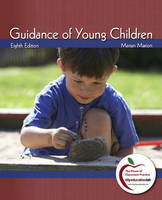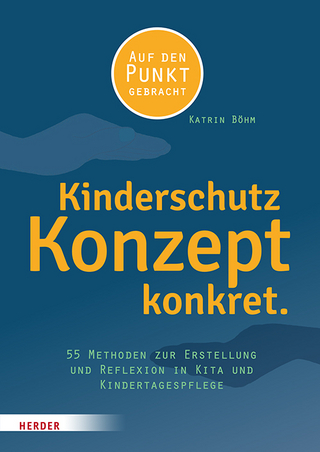
Guidance of Young Children
Pearson (Verlag)
978-0-13-703402-4 (ISBN)
- Titel erscheint in neuer Auflage
- Artikel merken
PART ONE: Guiding of Young Children: Three Essential Elements
1 A Teacher’s Role in Guiding Children
Vignettes
Beginning the Circle: Our Hope for Children
Major Dimensions of Caregiving Styles
Responsiveness
Demandingness
Styles of Caregiving
Authoritative Style
Authoritarian Caregiving Style
Permissive Caregiving Style
Basic Processes Adults Use to Influence Children (MIFPEC)
Analyze Vignettes
Summary
Questions for Reflection
Apply Your Knowledge
Key Terms
Web Sites
2 Theoretical Foundations of Child Guidance
Vignettes
Theories Focusing on the Systems in which Children Develop
Theories Focusing on How Children Construct Ideas
Theories Focusing on Psychological, Emotional, and Social Learning Needs
Analyze Vignettes
Summary
Questions for Reflection
Apply Your Knowledge
Key Terms
Web Sites
3 Understand Child Development: A Key to Guiding Children Effectively
Vignettes
Perception and Memory
Social Cognition: How Children Think about Others
Self-Control and Prosocial Behavior
Analyze Vignettes
Summary
Questions for Reflection
Apply Your Knowledge
Key Terms
Web Sites
PART TWO “Direct” and “Indirect” Child Guidance
4 Supportive Physical Environments: Indirect Guidance
Vignette
Theoretical Foundations for Early Childhood Classroom Design
Developmentally Appropriate Physical Environments for 3 to 8 Year-Olds
Guidelines: Developmentally Appropriate Room Design
Additional Considerations in a Classroom for 3 to 8 Year-Olds
Designing Spaces for Infants and Toddlers
Analyze a Vignette
Summary
Questions for Reflection
Apply Your Knowledge
Key Terms
Web Sites
5 Positive Guidance and Discipline Strategies: Direct Guidance
Vignettes
The Concept of Discipline
Positive Guidance: Description and Explanation
Beliefs About Discipline Influence Choices about Discipline Strategies
Analyze a Vignette
Summary
Questions for Reflection
Apply Your Knowledge
Key Terms
Web Sites
6 Using Observation in Guiding Children
Vignettes
Assessment in Early Childhood Education
Reasons for Observing Children’s Behavior
Practical Methods for Observing Children’s Behavior
Analyze a Vignette: Answering Some of the 5 “W” Questions about Behavior
Summary
Questions for Reflection
Apply Your Knowledge
Key Terms
Web Sites
PART THREE Special Topics in Child Guidance
7 Self-Esteem and Moral Identity
Vignettes
Parts of the Self
Building Blocks of Self-Esteem
Self-Esteem Develops in a Social Context
Moral Identity
Practices That Help Children Develop Authentic Self-Esteem
Practices Contributing to Unhealthy Self-Esteem
Analyze Vignettes
Summary
Questions for Reflection
Apply Your Knowledge
Key Terms
Web Sites
8 Feelings and Friends: Emotional and Social Competence
Guiding Questions
Vignettes:
Emotional Competence
Social Competence
Guiding Children’s Social Emotional Learning (SEL)
Analyze a Vignette: Learning that Using Words is a Good Thing
Summary
Questions for Reflection
Apply Your Knowledge
Key Terms
Web Sites
9 Resilience and Stress in Childhood
Guiding Questions
Vignettes
Resilience in Young Children
Types of Stressors
Acute and Chronic Stress
Sources of Stress
How Stress Affects Children
Stages in Responding to Stress
Coping Effectively with Stress
General Guidelines for Helping Children Cope with Stress
Suggestions for Helping Children Who Face the Stress of Moving
Analyze Vignettes: Helping Children Deal with Stress
Summary
Questions for Reflection
Apply Your Knowledge
Key Terms
Web Sites
10 Aggression and Bullying in Young Children
Guiding Questions
Vignettes
Aggression
Purposes of Aggression
Bullying: Aggression in Action
How Children Learn to be Aggressive
Strategies for Dealing with Bullying and Other Forms of Aggression
Analyze Vignettes
Summary
Questions for Reflection
Apply Your Knowledge
Key Terms
Web Sites
11 Minimizing Challenging Behavior
Vignettes
Challenging Behavior
Roots of Challenging Behavior
Decision-Making Model of Child Guidance
Specific Challenging Behaviors: Using the Decision-Making Model of Child Guidance
Persistent Behavior Challenges
Summary
Questions for Reflection
Apply Your Knowledge
Key Terms
Web Sites
PART FOUR Apply Your Knowledge of Child Guidance
12 Guiding Children during Routines and Transitions
Vignettes
Arrival and Departure
Large Group
Small Groups
Transitions
Analyze Vignettes: Using Direct and Indirect Guidance during Routines and Transitions
Summary
Questions for Reflection
Apply Your Knowledge
Key Terms
Web Sites
13 Use the Decision-Making Model of Child Guidance
Guiding Questions
Vignette: What Should We Do About The Cursing?
Decision-Making Model of Child Guidance
Steps in the Decision-Making Model
Using the Decision-Making Model in Everyday Discipline Encounters
Develop Guidance Plans
Coming Full Circle: What the Decision-Making Model Means for Children
Analyze a Vignette: What Should We Do about the Cursing?
Summary
Questions for Reflection
Apply Your Knowledge
Key Terms
Web Sites
Appendix: Review: Major Positive Discipline Strategies
References
Author Index
Subject Index
| Erscheint lt. Verlag | 1.6.2010 |
|---|---|
| Sprache | englisch |
| Maße | 188 x 231 mm |
| Gewicht | 630 g |
| Themenwelt | Sozialwissenschaften ► Pädagogik ► Schulpädagogik / Grundschule |
| ISBN-10 | 0-13-703402-4 / 0137034024 |
| ISBN-13 | 978-0-13-703402-4 / 9780137034024 |
| Zustand | Neuware |
| Informationen gemäß Produktsicherheitsverordnung (GPSR) | |
| Haben Sie eine Frage zum Produkt? |
aus dem Bereich



